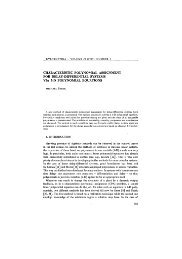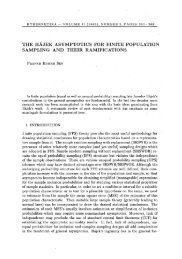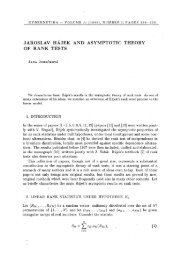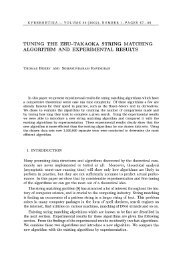polynomial controller design based on flatness - Kybernetika
polynomial controller design based on flatness - Kybernetika
polynomial controller design based on flatness - Kybernetika
Create successful ePaper yourself
Turn your PDF publications into a flip-book with our unique Google optimized e-Paper software.
Polynomial C<strong>on</strong>troller Design Based <strong>on</strong> Flatness 581<br />
where K(p) = p 2 +kip+ko defines the error dynamics. Prom u(t) = (p 2 + p + l) z(t)<br />
and y(t) = (p + 1) z(t), we have:<br />
Z(t) =<br />
0 1<br />
-1 -1<br />
y(t) =[11]<br />
Z(t)<br />
Z(t) +<br />
u(t),<br />
(62)<br />
The chosen closed loop poles are —4.2 ± 4.28j and lead to the following RST<br />
<str<strong>on</strong>g>c<strong>on</strong>troller</str<strong>on</strong>g> in the realizable form (50):<br />
RTfr- 1 ) = l-27.Qp-\<br />
S*^- 1 ) = 35 + 27.6P" 1 ,<br />
K(p) = p 2 + 8Ap + 36.<br />
(63)<br />
In order to cope with a static perturbati<strong>on</strong>, added to the system output, an<br />
integral acti<strong>on</strong> must be integrated into the model and <strong>on</strong>e obtains the augmented<br />
model:<br />
y(t)<br />
p+1<br />
p(p 2 ӣ(t), (64)<br />
+P+1)<br />
where u(t) = pu(t) and A(p) = pA(p). The RST <str<strong>on</strong>g>c<strong>on</strong>troller</str<strong>on</strong>g> corresp<strong>on</strong>ding to this<br />
model is given by:<br />
яҶp- 1 )<br />
Š*(p~ l )<br />
Ќ(p)<br />
= l-22.4 ř<br />
r 1 + 379íT 2 ,<br />
= 517.6+ 379p _1 ,<br />
= p 3 + 23.4p 2 + 162p + 540,<br />
where the chosen closed loop poles are: —4.2 ± 4.28i, —15. The trajectory to follow<br />
by the output is y d<br />
(t) = 1. To achieve this purpose, the desired flat output must<br />
have the following expressi<strong>on</strong>:<br />
(65)<br />
z d<br />
(t) = 1 --yexp(-t), (66)<br />
which satisfies the derivability c<strong>on</strong>diti<strong>on</strong> for any c<strong>on</strong>stant 7. It can be noted here that<br />
the obtained <str<strong>on</strong>g>c<strong>on</strong>troller</str<strong>on</strong>g> does not reject the added c<strong>on</strong>stant perturbati<strong>on</strong> as shown in<br />
Figure 1 (for 7 = 1).<br />
By applying the same methodology replacing the operator p by the operator ir<br />
as proposed previously, the state representati<strong>on</strong> becomes:<br />
ҡŽ(t) = Ã а<br />
Ž(t) + Bй(t),<br />
y(t) = ÕŽ(t),<br />
(67)<br />
where Z(t) = ( z(t) z^ (t) z^ (t) ) and z(t) is the flat output of the augmented<br />
model. A a represents the matrix A + als. The same methodology is applied and the<br />
following RST expressi<strong>on</strong> is obtained:<br />
K^- 1 )^) = K(p) z d (t) - S^TT" 1 ) y(t), (68)






